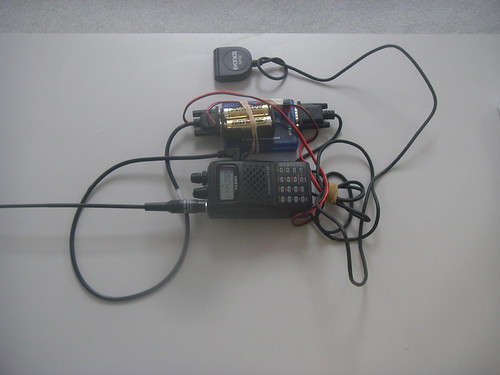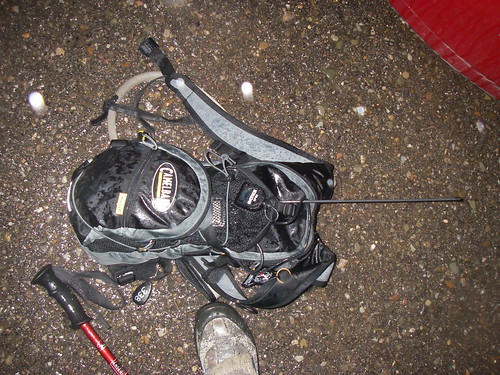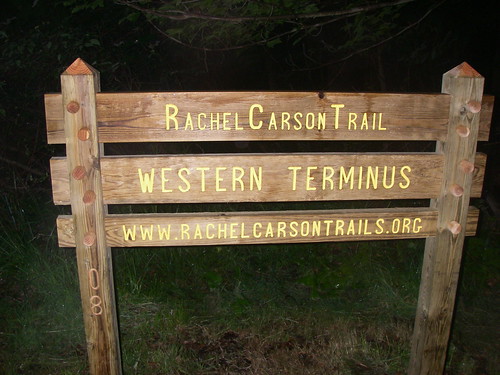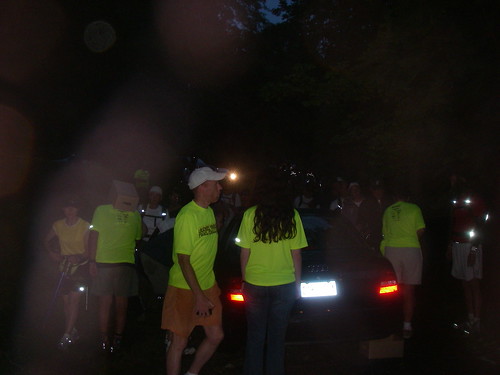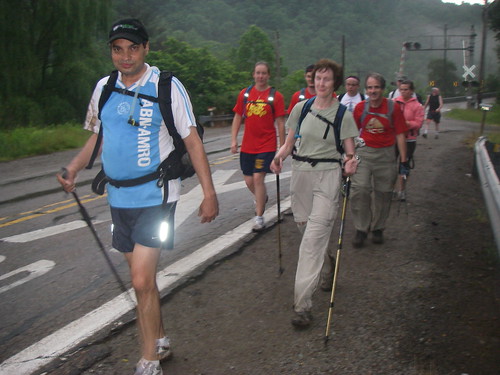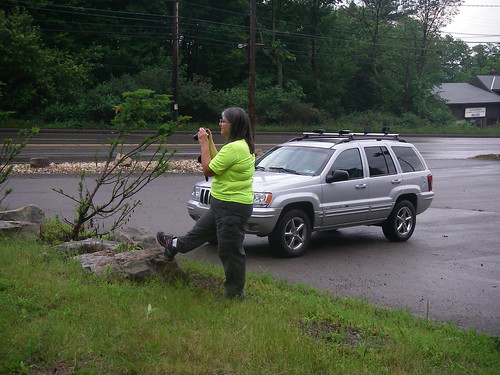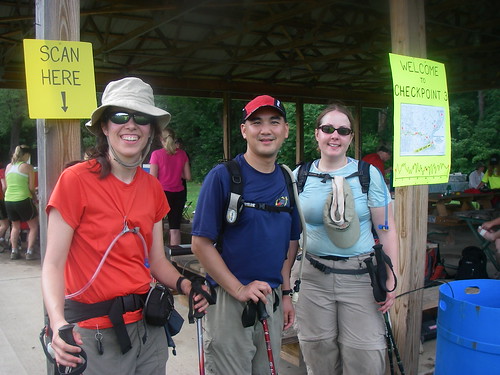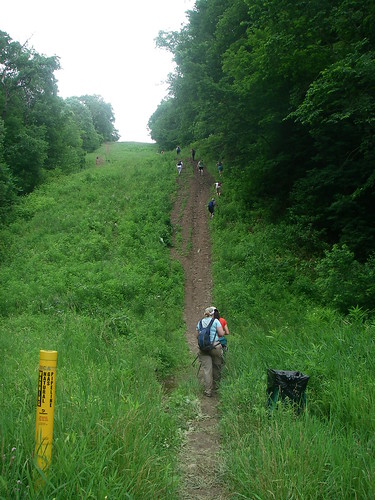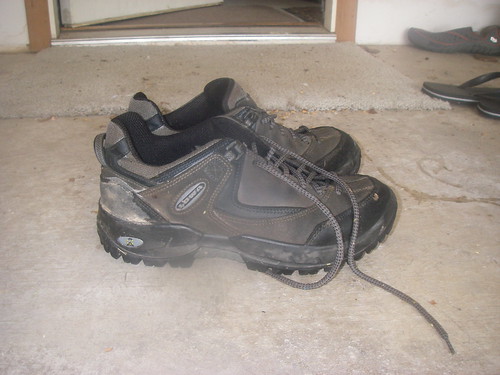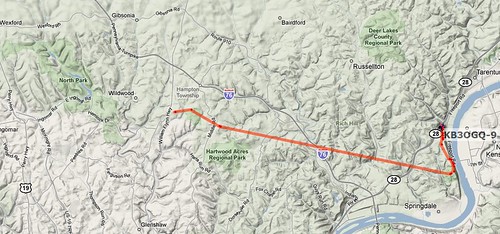An account of my first trip to China to meet my wife's family in Tianjin and friends in Beijing and Shanghai.
Tianjin
Beijing
Shangai
Tianjin Pt 2
Quotes
Conversation topics
I arrived in Beijing on Friday afternoon. On arrival, the plane was inspected by health officials who inspected everyone using a hand held temperature sensor. Those who were flagged where then inspected using a second sensor, which I assume is more accurate. Only after everyone was inspected was the plane cleared to depart. With the swine flu scare in full swing (in the past week Japan had reported over 100 cases) there were three more checkpoints with temperature sensors manned by health inspectors before we reached immigration and customs.
S was waiting for me out of customs, and we went downstairs to take the Tianjin bus. We took that to the Tianjin bus station, and met S's father there who picked us up.
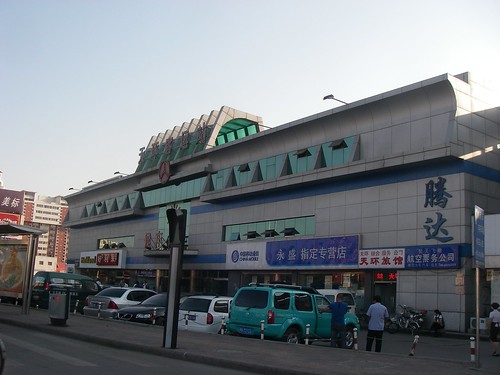
Tianjin
In Tianjin, we spent a lot of time walking around the neighborhood. Her family still lives near the Tianjin Conservatory of Music, which was the center of both her life and her mother (who worked there). So we went to markets in the area, her school (all three campuses), and various shops (including a tea shop her mother frequents, where we had two sets of tastings to pick teas to bring back.) S and her mother are in some pictures on the Conservatory wall of fame in the courtyard.
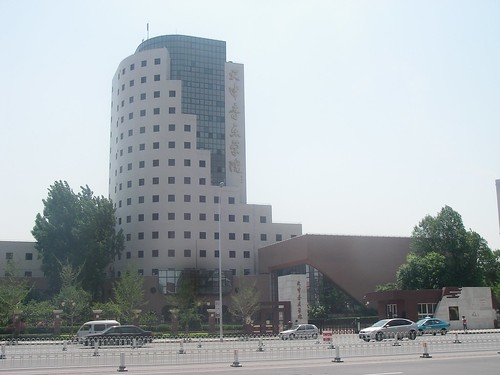
Tianjin traffic is pretty bad. It is not that it is heavy (Bangkok is much heavier), but the drivers are very aggressive, in the disfunctional Boston way (meaning not the New York aggressiveness that has obvious purpose of people trying to get somewhere, but aggressiveness that is clearly sub-optimal because every expression of aggressiveness probably slows down everyone, including the driver jumping in.) For example, red lights are merely suggestions, drivers tend to view pushing across an intersection against a red light as a legitimate possibility. Which causes cross traffic to stop when they reach him, and invariably the crosser gets trapped in the intersection as cross traffic goes through before he makes it across, trapping everyone else. Also, pedestrians cross anywhere, anytime, secure in the knowledge that Chinese law is punative against drivers who touch pedestrians. In contrast to, say Bangkok where I think every pedestrian is fully aware that they don't count for all that much against a car.
The signs are somewhat odd. Many of the public advisory messages consist of a picture and text. But the picture is of what NOT to do, and you have to read the text to realize this. So you have pictures of cars hitting each other, drivers and phones, drinks, etc. Although my favorite sign does utilize the universal circle and line symbol for No. It is a symbol of a horn, which I find exceptionally funny at the Tianjin Conservatory or the Tianjin Music Hall.
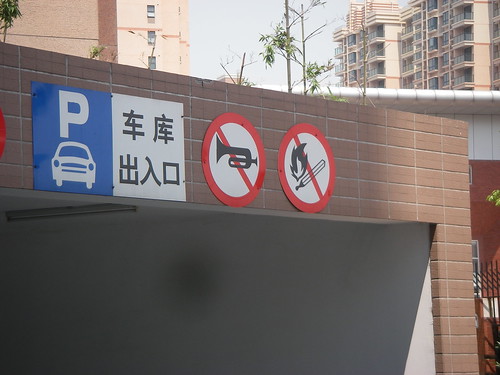
This one is actually in Shanghai, but there were such signs in Tianjin as well.
We visited S grandmother in the hospital, multiple aunties and uncles. A few cousins.
One morning we went to the morning market nearby where the W family lives. At that hour in the morning, that road is mostly closed. In addition, there are some roads that are closed to vehicles, which leads to a large pack of bicycles like the old days.
In the market you can get all sorts of things. We got car seat covers, socks, some herbs, and breakfast. There was all sorts of fruits, vegetables, fish, meats, housewear, and one guy who seemed to have assorted everything.
One of the more famous restaurants is Go Buli (the english on the sign says 'Go Believe') It is known for its steamed buns. The story of the restaurant is the founder was universally poorly regarded, and even the dogs ('go') did not ('bu') look at him ('li'). But, it has become successful, and these restaurants are found throughout the country and Tianjin is known for its steamed buns.
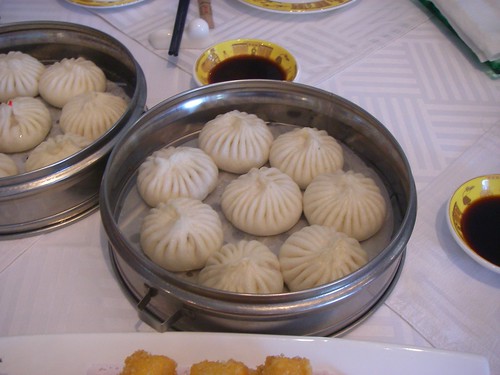
Beijing
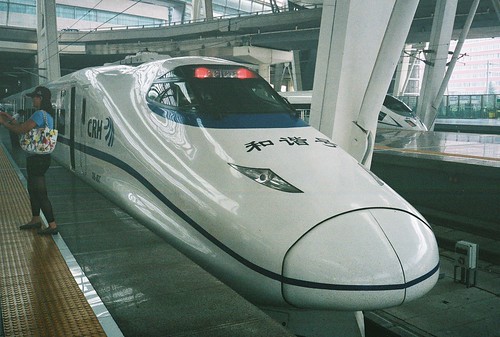
We took the bullet train to Beijing. It takes about 1/2 hour and arrives at the Beijing-South railway station. Which somehow lacks an associated subway station. Very inconvenient. We took a bus to the nearest train station, then went to the Forbidden City, under the theory that we should do touristy things on our own instead of subjecting our friends in the area to such things. We took lots of pictures, including a close-up of the Mao portrait at the front wall of the Forbidden City, which seemed to attract the attention of a nearby guard who was apparently satisfied that I was not taking pictures of anything else as we went in.
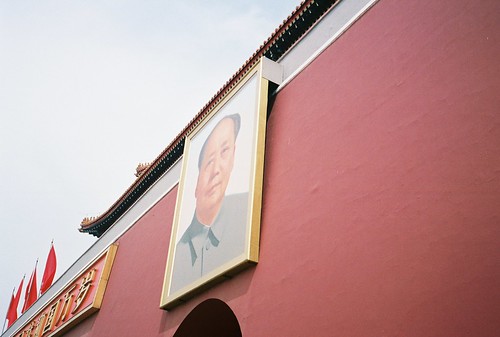

We had lunch in Dongsi, the neighborhood north and east of the Forbidden City. We were pointed that way by a tea shop worker where we called friends. We went into a little side street (Houjie) and found a noodle place to have noodles.
S's friend lives by the Today Museum of Art, so we went there to hang out at their place. CL's husband, Chen Leiji, played the Guqin at the 2008 Olympic Opening Ceremonies during the Scroll of Chinese Paintings segment.
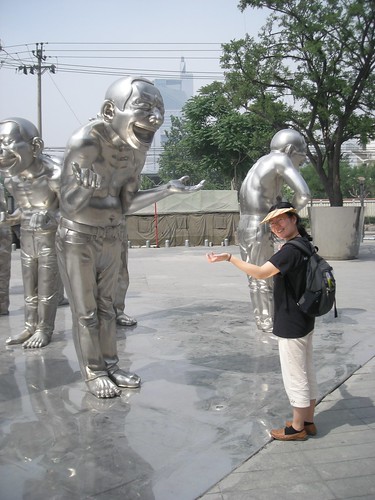
We had dinner in a restaurant at Apartment #8 along with CL and family, JY (from Northwestern) joined us as well as CL's friends. Very good seafood. Interesting dishes of varying quality from ok to very good.
We stayed at Motel168 by Andinglu station. The next morning, we got buns made at a street stall right next door. Next we went to the subway to go to Olympic Park. But first, we decided to take a detour in a small park along the way. Which turned out to be a fairly long park following a small river that ran through the center of the city. We saw many nanny's with babies and retirees. There was also a saxaphone player, an erhu player, some people doing tai chi, and one group that took over a pavilian to play chinese instruments and sing opera.
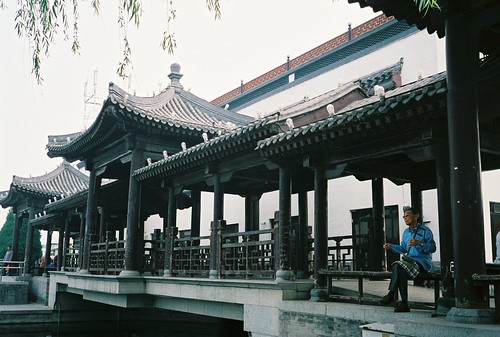
We took the train to Olympic park. Line 8 (of course!) was a spur line that went to the park. We took pictures of some public sculpture as well as the Bird's Nest and the Water Cube.
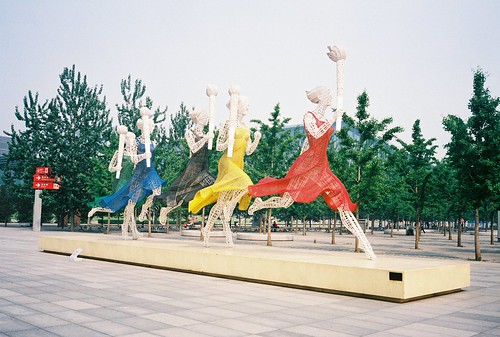
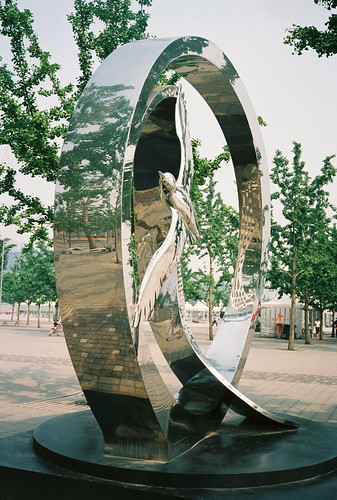
Then we went for lunch. First we went to Wangfujing street to look. We had lamb on a stick (where we suspect the vendor cheated us of change. grrr) and coconut. Neither was all that good, although there was some entertainment value at looking at live scorpions on a stick. We ended up eating at Quanjude Roast Duck restaurant, the original Peking duck restaurant. Very good food there.
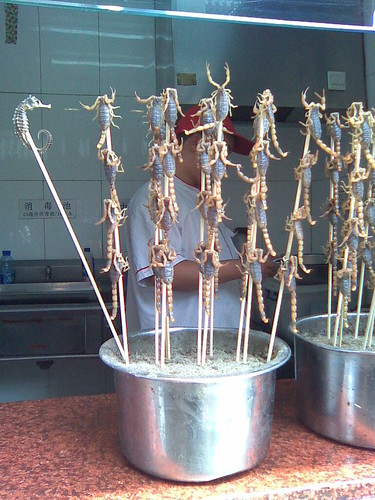

Shanghai
Compared to the new Beijing South and the Tianjin train stations, Shanghai's train station seems designed to make taking a trip as hard as possible, with multiple, separate buildings for getting tickets, lines for getting in the station, and multiple wings with waiting areas. And then the Shanghai crowds and subway. This was the first day of the Dragon Boat festival holiday, so there were large crowds at the station. But here as well as on the subway and everywhere else we went, there was an obvious increase in bumps-per-unit-time indicator of social aggressiveness. My best illustration. We had taken a spur line to the transfer point at the end of the line. At the transfer point (the end of the line) we see the people in the station getting ready to get on the train (which is about to empty, since it is the end of the line). And there is no space for all of us to get through. Looking out the door, what follows would be obvious. When the doors open, the whole wall of people outside surges to get in, while everyone in the train trying to get out (which is all of us) surge to get out. And the effect is not dissimilar to a rugby scrum. Right down to my bracing myself for the initial impact. I felt sorry for the poor ai yee behind us, who cried out "aiyaa" as the doors opened and she saw the scrum she needed to get through to get off the train.
Shanghai was with my former roommate S and K and their two sons and two daughters. They live in a complex on Tianshanlu in the west part of the city (by Weininglu station). A in particular seemed to enjoy our visit as she had the unusual experience of having multiple adults with her with no other kids to compete.
After a shower and a bit of rest, S and I took the subway to People's Square. We went to the Shanghai Urban Planning Exhibition Hall, which was dominated by a model of Shanghai, and our introduction to the ubiquious preparations for the 2010 World Expo to be in Shanghai.
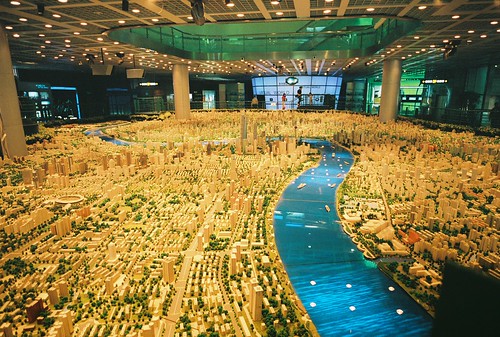
Which was indicated in signs and public sculpture all over town. Even in the depths of non-touristy neighborhoods you were faced with the exhortations of 'Better city, Better life' accompanied by the requisite cute mascot.
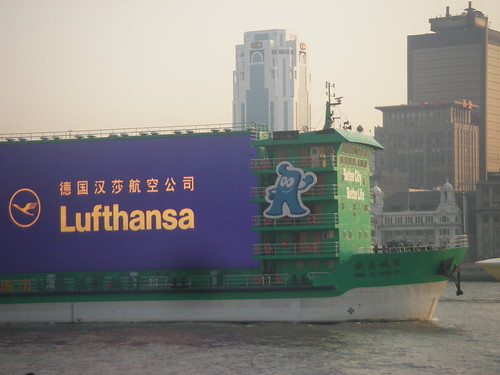
Next we took the bus to the Yuyuan bazaar (by Yuyuan garden). Very crowded. We had lunch in a food court type place right before that. Nothing exceptional. Next we tried to walk on the Bund. But we soon found out that there was construction along the whole way. So a taxi to Pudong was in order.
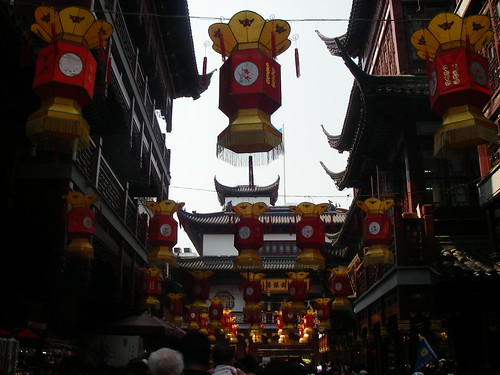
We wook a taxi to the Super Brand Mall, near the Oriental Pearl Building. It is the standard 9 story Asian mall catering to the middle class. We walked through there as well as Riverside Park. Dinner was with ST and A at Ding Tai Feng, featuring Xiao Long Tung Bao, their version of steamed buns is characterized by soup inside the bao (meaning you really need to eat the bao whole). ST knows of this from Taiwan, where it was a little hole in the wall. Now, it is something that is moderately upscale in Shanghai and other major cities around the Pacific Rim.
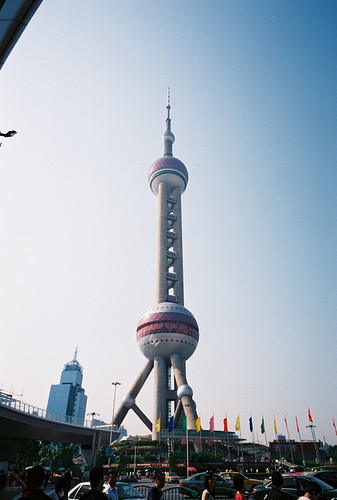
We went up to the 87th floor of the Grand Hyatt to take a quick look at the Shanghai skyline, then went down to the 54th floor where we stopped for coffee. A was enjoying her extended alone time with daddy well past her normal bedtime. And doing some importing things like teaching her guests how to play a driving game on her phone. (Note: while knowing how to go faster is nice, the next major advance is learning how to go left or right).
The next day, S and I went to Qibao, a water town in the west part of Shanghai. Using our guidebooks and the wonders of the internet, we mapped out a route using a combination of subway and buses to get there. Which was followed by asking many people how to find it. An endeavor in which we teamed up with another local couple who was trying to do the same thing. And when we finally found it, we found that there is now a subway stop, right outside the gate. The line is so new that it did not show up on our guidebook maps. Which shows how fast the place is growing.

Qibao is a tourist town. A bit out of the way so not as deadly as Yuyuan Garden, but still close enough to be accessible by public transit (and fewer foreigners). There is a pedestrian mall outside Qibao (where we shopped at a store that was closing globally). At Qibao itself, we got the pass for the touristy spots like the replica merchant house and garden, and the shadow puppet theater.
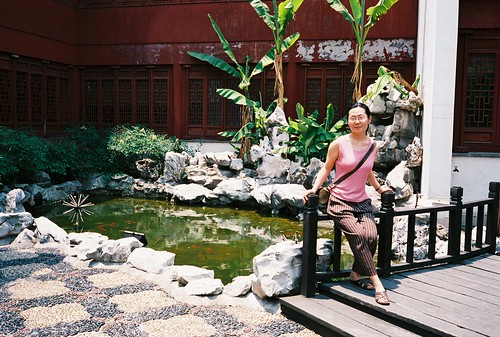
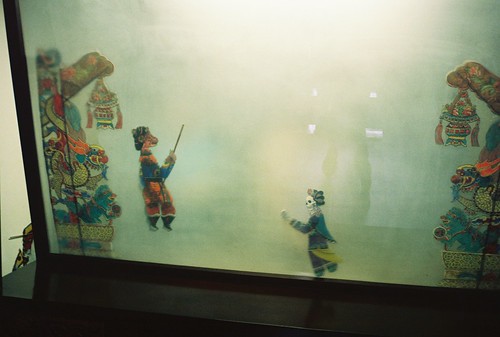
This was most useful as a quiet place to hide from the crowds in the town (which was probably consistant with the original idea). The main part was full of little shops, of pseudo antiques, food (conventional and more interesting), and other stores. And the canal with boats (after all, this is a canal town). The narrow streets of shops made it very crowded with bustling shoppers, yelling merchants hawking their wares. Creating the purely intentional effect of a crowded old time market (as opposed to the modern mall)
We returned to the T's after lunch, and hung out with the kids for watercoloring and pizza. Then it was on the bullet train back to Tianjin.
This time we took a normal sleeper car instead of first class like we did on the way down. It was not terribly crowded. We were thinking of upgrading to first class, but it turned out we had our 6 bed compartment to ourselves, so we stayed. Our conductor was very amused as we were asking her about how that worked, and she found out that I was American (Your husband is American?! Your English must be very good) In comparison to first class, the normal sleepers had 6 beds instead of 4 and no compartment door. The car as a whole was only about 2/3 full, so it was not terribly loud, but the car got cold overnight as people did not close the car door, leading it getting very cold with the wind going through the car. Someone took one of our extra blankets, and in the morning, there was a lot of sniffling going on in our car. I can see why the Chinese are terrified of Swine Flu. If it got into the passenger train system . . . (or either Golden Week *shudder*) They should just include face masks as part of the ticket price here.
Tianjin final
The last stretch in Tianjin was marked by visits with relatives (who wanted to wait until they were sure I was in China long enough to be sure I was not bringing Swine Flu in from the United States). S's mom's birthday (we got her a cake),
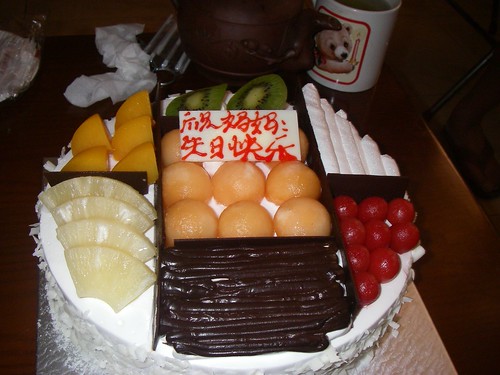
We met with S's schoolfriend L, who is still at the Tianjin Conservatory of Music, getting ready for her Master's recital. She dragged S's parents along with us for lunch at a restaurant in Tianjin that was notable for the many antiques on display along the walls including bells, many Buddha statues (and one idol that S's mother made a point of stopping by, which was for praying for children).
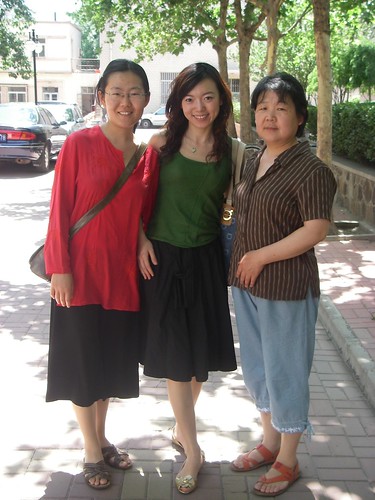
We also had a couple trips to the large pedestrian mall in Tianjin, in our ongoing quest to find S qipao suitible for future galas. S's mom knew of many of the older department stores and dress shops along the way. Some of the other prominent stores: a very large number of wedding studios and wedding companies. Several Li-ann sporting goods stores. I think there was one every 100 meters, just to make sure you saw it. To be sure, there were several Adidas and Nike stores too, but Li-ann was pervasive. (Note: whoever setup Walmart here did an excellent job. Ditto Nike's NBA-China marketing account. Those people deserve whatever they make and I hope they got a good bonus as well.)
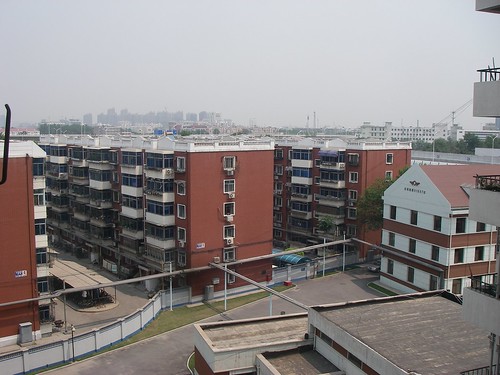
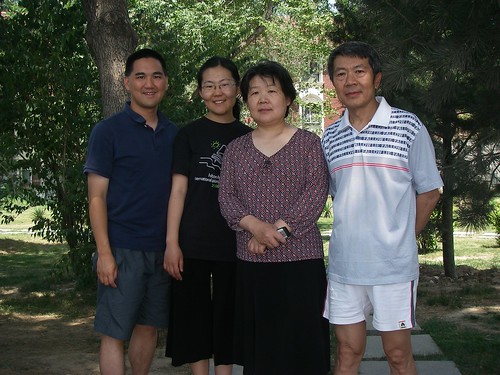
QUOTES
Numerous occasions with variations:
When are you going to have kids?
In Beijing:
Look what your friend CL gave me. He played in the Olympics!
To S's mom:
When are you going to America to take care of your grandchildren? (Note: S is an only child)
In Shanghai trying to get to Qibao:
Why are you going to ancient city Qibao instead of the clubs and bars?
Numerous occasions:
He does not look American.
In Shanghai:
ST: We're not going to be contributing to the cause of grandkids. Staying with the T's is worth several months of birth control.
On the train from Shanghai to Tianjin:
He does not look American.
Your husband is American? Your english must be very good.
L in Tianjin:
We have to go to the antiques restaurant. You are our international friend.
I approve. (of me)
Immigration at Dulles International Airport:
What is your profession? (after reviewing my assorted visas)
Conversation topics
When are you going to have kids?
How fast buildings are going up in Tianjin/Beijing/Shanghai
How do you like the restaurants in Beijing?
How does the economic downturn affect you?
The trends in quality of Chinese conservatories.
The raising of children in China (AKA the Lang Lang model of parenting AKA why people our age in China don't want kids)
Tianjin's tourist aircraft carrier restaurant (AKA why you do not buy a ship made by russians)
Children's day!
The need to have pretty girls greeting people at stores/restaurants/etc. (AKA when you have 1.5 billion people, it is not too hard to find pretty girls to be greeters/hostesses.)
Global warming (AKA everyone in China believes in Global Warming, because no emporor of China would build his capital in the dessert (Beijing) )
